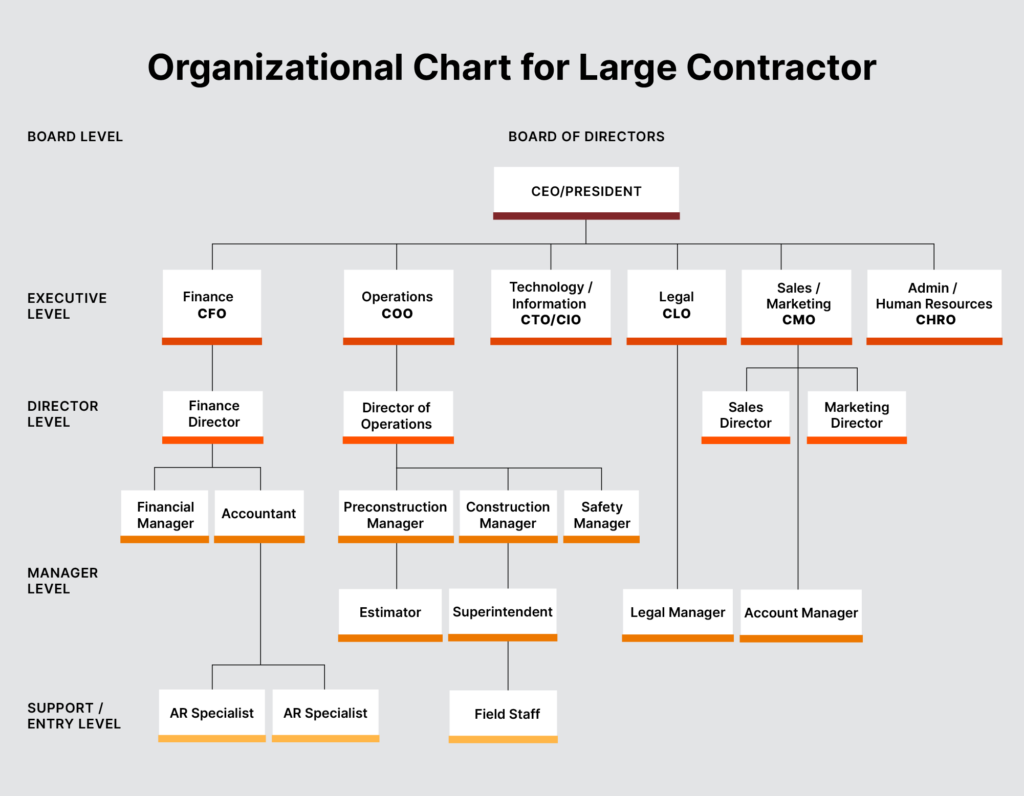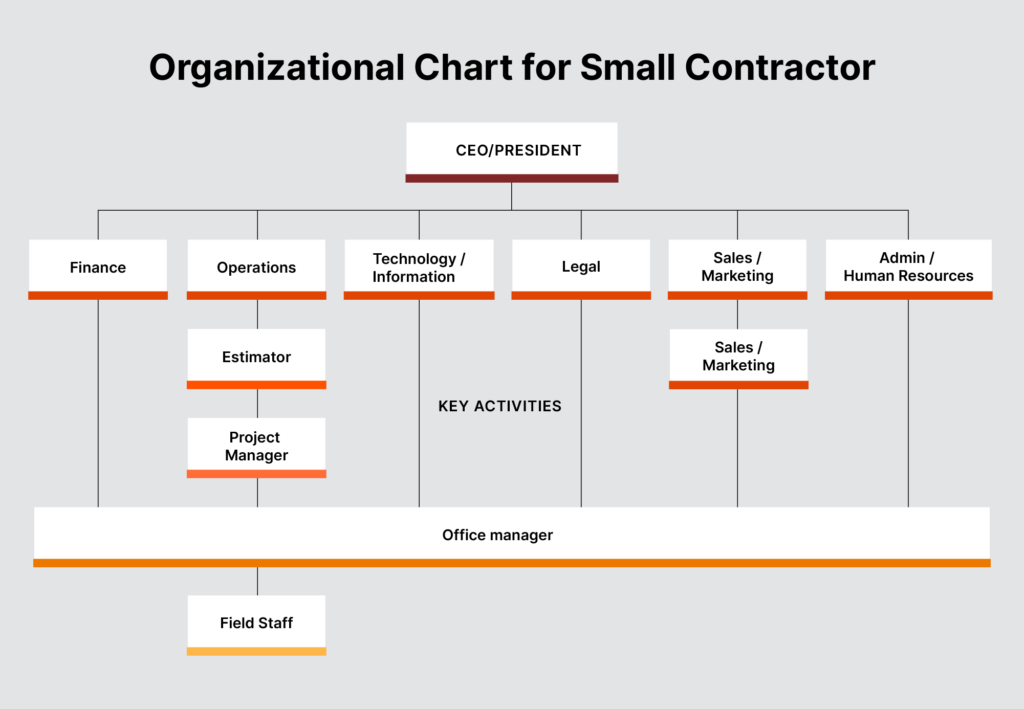— 8 min read
Construction Company Hierarchy: Creating an Organizational Chart


Last Updated Jul 25, 2025

Jacob Kunken
Solutions Engineer, Heavy Civil
28 articles
Jake Kunken currently works as Solutions Engineer for Procore's Heavy Civil division. He brings 14 years of experience working in various construction roles in New York and Colorado, including laborer, assistant carpenter, carpenter, assistant superintendent, superintendent, construction manager, safety manager, and project manager. Jake also spent time in EHS as an environmental engineer for Skanska. He’s worked on more than 40 commercial projects from ground-up, to heavy civil, hospital work, and tenant improvement. Jake studied Ecological Technology Design at the University of Maryland.

Megan Duncan
Megan Duncan is an award-winning journalist based in Hannibal, Missouri. Her work has been featured on Muddy River News, Hannibal Courier-Post, The Whig, Hannibal Magazine, Q Magazine and Her View from Home. She has won two Best of Press Awards including first place from the Illinois Press Association for Localized National Story and third place from the Missouri Associated Press for best humor column. She holds a Bachelor of Arts in Communication from Quincy University.
Last Updated Jul 25, 2025

An organizational chart is an important component of any construction business, offering a visual representation of the hierarchy and delineating decision-making responsibilities within the firm. An effective org structure clarifies responsibilities, promotes informed decision-making and eliminates bottlenecks. This article explores common roles in a construction company and their typical positions in an organizational chart, as well as different approaches to organizing teams for efficient operations at scale.
Table of contents
The Importance of an Organizational Chart
Prevents Overlap
By delineating specific roles and responsibilities, org charts help prevent overlap and confusion. Each position has a clearly defined scope, minimizing the risk of redundant work.
Facilitates Proper Delegation
Org charts aid in assigning tasks appropriately and maintaining efficiency. Proper delegation helps stop bottlenecking.
Aids in Training
For new employees, understanding a company's organizational structure can be overwhelming. A well-designed org chart provides a clear picture of the company’s hierarchy, helping new hires quickly grasp who is responsible for what and where they fit within the organization.
Hierarchy in a Construction Company
While each construction company is unique in terms of geographical location, types of projects and personnel, there are common organizational structures that well-designed companies typically follow.
Regardless of the company size, the responsibilities associated with different tiers remain consistent. Large companies may allocate these responsibilities across multiple individuals, whereas smaller firms may consolidate multiple duties in a single role.
Construction companies have distinct levels, or tiers, of responsibility. Progressing down the organizational chart, roles transition from strategic and managerial to task-specific. At the lower levels, there could be numerous employees, each handling a segment of the overall work.
Ownership
In large construction firms, a board of directors often sets the company's overarching direction, with a chief executive officer (CEO) reporting to them. Smaller contractors may have a single individual, such as the president or owner, at the helm.
Executive
The executive team collaborates closely with the CEO to develop and disseminate company strategy. Large construction companies typically have a varied executive team, each member leading a specific division. Titles such as vice president or chief officers — such as “VP of Operations” or “Chief Financial Officer (CFO)” — are common.
Director
In larger construction companies, several directors operate under the executives. For instance, there may be a marketing director, engineering director, sales director and director of operations. Generally, the engineering and operations directors report to the chief operating officer (COO), whereas the Sales and Marketing Directors may report to the chief marketing officer (CMO).
Manager
Below the director level is the managerial tier. Managers oversee their respective teams, with roles such as financial managers, accountants, construction managers, job superintendents, project managers and marketing managers. Larger companies may have multiple managers across various divisions and projects.
Support
Support staff execute essential tasks to assist managers and directors within each division. They report to managers and hold positions such as assistant managers, office managers, account managers and assistant project managers. In larger firms, these job titles may include several individuals to distribute responsibilities effectively.
Entry-Level
Entry-level roles are crucial starting points, particularly in large construction firms. This tier typically includes administrative assistants, interns and specialists. Some assistant project managers may also begin at this level.
Linking Organizational Charts to Performance Metrics
An effective organizational chart not only helps define roles and responsibilities but also tracks and improves performance. By clearly outlining reporting relationships and responsibilities, an organizational chart can help monitor key performance indicators (KPIs) and make sure each team member's contributions are aligned with the company's overall goals.
When I think about how organizational charts come into play, I remember a large subway project I worked on. There were multiple superintendents on the project—each handling different things. We had one superintendent in charge of mechanical work, another for concrete work and so on.
Everyone knew who to report to, and it made communication smoother on-site. It was a huge help for new team members who came on board because they could just look at the chart and understand the hierarchy right away.

Jacob Kunken
Solutions Engineer, Heavy Civil
Procore Technologies
Steps to Creating an Effective Org Chart
1. Understand business needs.
Begin by assessing the construction company’s specific needs. Consider factors such as the scale of operations, project complexity and the range of services offered. This understanding will help guide the structuring of the org chart to align with the company’s goals and operational requirements.
2. Clearly define roles and responsibilities.
Clearly define each role within the organization. Specify responsibilities, tasks and expectations for each position. This clarity helps prevent confusion and makes sure that everyone understands their duties and the scope of their work.
3. Establish reporting relationships.
Determine how different roles and departments connect. Establish reporting lines to clarify who reports to whom and how information flows through the organization. This helps streamline communication and decision-making processes.
Choosing the Right Structure
The structure of an org chart can vary based on the company’s size and operational needs. The two primary types of structures are:
Flat Structure
Common in smaller organizations, a flat structure has fewer layers of management with a more collaborative and flexible work environment. In this structure, employees often have broader roles and more direct communication with higher-level managers.
Functional Structure
Larger organizations often use a functional structure where roles are divided into distinct departments (e.g., finance or operations). Each department is managed separately, and employees report to department heads. This structure allows for specialization and more defined roles and can create more layers of management.
Courses about construction.
For construction.
Unlock your career potential with our free educational courses on Health & Safety, Data in Construction, and more.
Maintaining and Updating Org Charts
Org charts need to stay as current as possible. When roles, responsibilities or reporting lines change within the company, the chart should be updated to reflect the current organizational structure.
The org chart must also be easily accessible to all employees. Keeping it available helps employees understand the organizational structure and reporting relationships, which helps improve communication and efficiency.
Factors That Affect Company Structure
Type of Company
Construction companies come in various forms, each with unique organizational needs. Here’s a look at how different types of construction companies might structure their org charts:
Owner/Developers
These companies manage the development and oversight of construction projects. Their org charts often focus on project oversight and financial management. Key roles may include the Owner/President at the top, with layers of management overseeing project development, financial planning and strategic decision-making.
For example, the construction division of a university is often organized under the finance or capital planning department.
General Contractors
General contractors coordinate the overall execution of construction projects. Their org charts often include roles related to project management, procurement and subcontractor coordination. There may be positions like project managers, construction managers and procurement officers within their structure.
Specialty Contractors
These companies focus on specific construction areas, such as electrical work or plumbing. Their org charts are usually organized around specialized functions and project teams. For example, an electrical contractor might have roles such as electrical project manager, electrical engineer and field electricians.
Company Size
For smaller construction companies, such as those with fewer than 50 employees, individuals often wear multiple hats. For instance, the chief operating officer may also act as the general project manager due to limited resources. These companies should clearly reflect dual roles on their org chart to avoid confusion and ensure everyone understands their responsibilities.
For larger organizations, the organizational chart is more dynamic and should be frequently updated. This flexibility is necessary to accommodate changes such as new hires, layoffs or organizational shifts. An interactive, digital org chart helps manage this complexity by providing real-time updates and a clear view of the reporting structure.
Administrative vs. Project Functions
Construction companies generally have two main employee functions:
- Administrative/Office/Business Functions: These roles focus on the overall management and operation of the business. Examples include finance managers, HR specialists and marketing directors. This lane ensures that the company’s business operations run smoothly and that administrative tasks, such as scheduling, are handled effectively.
- Project Functions: These teams concentrate on delivering and managing specific projects. These roles can include construction managers, estimators and project superintendents. Project functions are an essential part of construction projects and help tasks to be completed on time and within budget.
Best Practices for Organizing a Construction Company
Utilizing the org chart is the best way to ensure its efficiency. The chart should be the company's go-to when establishing communication without veering away from it.
When designing and implementing an org chart, consider the following best practices:
Adapt to company size.
Recognize that the structure of an org chart will differ based on the size of a company. Smaller companies might have a simpler structure with fewer layers of management, while larger companies will require a more complex chart with multiple departments and specialized roles.
Maintain flexibility.
Be prepared to adapt the org chart as the company grows or changes. An org chart should be a living document that evolves with the company’s needs. This flexibility helps accommodate new roles, projects and business strategies.
Communicate clearly.
Use the org chart to create a communication flow within the company. Clearly defined roles and reporting lines help employees understand who to approach for various issues and more efficient problem-solving.
Construction Company Organizational Chart Examples
The organizational chart for a large construction company can be complex, with roles that are often highly specialized. They may have a whole team of accounts receivable specialists or credit managers, each one assigned to oversee their own specific accounts.

For many, construction is still very much a family business. These contractors may only have a handful of employees.

Building the Right Organizational Structure
An effective organizational chart is essential for any construction company, regardless of its size or type. By providing a clear visual representation of roles and reporting relationships, org charts help prevent overlap, promote proper delegation and create efficient communication channels.
Was this article helpful?
Thank you for your submission.
95%
5%
You voted that this article was . Was this a mistake? If so, change your vote
Scroll less, learn more about construction.
Subscribe to The Blueprint, Procore’s construction newsletter, to get content from industry experts delivered straight to your inbox.
By clicking this button, you agree to our Privacy Notice and Terms of Service.
Thank you!
You’re signed up to receive The Blueprint newsletter from Procore. You can unsubscribe at any time.
Categories:
Written by

Jacob Kunken
Solutions Engineer, Heavy Civil | Procore Technologies
28 articles
Jake Kunken currently works as Solutions Engineer for Procore's Heavy Civil division. He brings 14 years of experience working in various construction roles in New York and Colorado, including laborer, assistant carpenter, carpenter, assistant superintendent, superintendent, construction manager, safety manager, and project manager. Jake also spent time in EHS as an environmental engineer for Skanska. He’s worked on more than 40 commercial projects from ground-up, to heavy civil, hospital work, and tenant improvement. Jake studied Ecological Technology Design at the University of Maryland.
View profile
Megan Duncan
Megan Duncan is an award-winning journalist based in Hannibal, Missouri. Her work has been featured on Muddy River News, Hannibal Courier-Post, The Whig, Hannibal Magazine, Q Magazine and Her View from Home. She has won two Best of Press Awards including first place from the Illinois Press Association for Localized National Story and third place from the Missouri Associated Press for best humor column. She holds a Bachelor of Arts in Communication from Quincy University.
View profileExplore more helpful resources

How AI Is Creating Big Advantages for Specialty Contractors
Every minute that an MEP contractor takes to file an RFI, untangle a scheduling knot, or search for a forgotten document is a minute spent not building something. Enter artificial...

How GCs Can Minimize Waste With a Strong Inventory Management System
Construction is a very fluid and fast-paced industry. Any given jobsite might have thousands of moving pieces, plus new items showing up on the loading dock day after day. In...

Construction Business Intelligence: From Data to Decisions
Leaders in the construction industry can now access a vast array of construction data through sophisticated construction business intelligence tools. Within this data lie insights that support daily decision-making and...

Winning Buy-in for Automated Technology From the Trades
Automation in the MEP trades has the power to deliver productivity gains, schedule certainty, improved quality, and enhanced safety — but often, workers fearful of losing their jobs can stand...
Free Tools
Calculators
Use our calculators to estimate the cost of construction materials for your next project.
Templates
Find a template to help you with your construction project tasks.
Material Price Tracker
Get the latest U.S. retail prices and view historical trends for common building materials.
Glossary
Explore key terms and phrases used in the industry.
